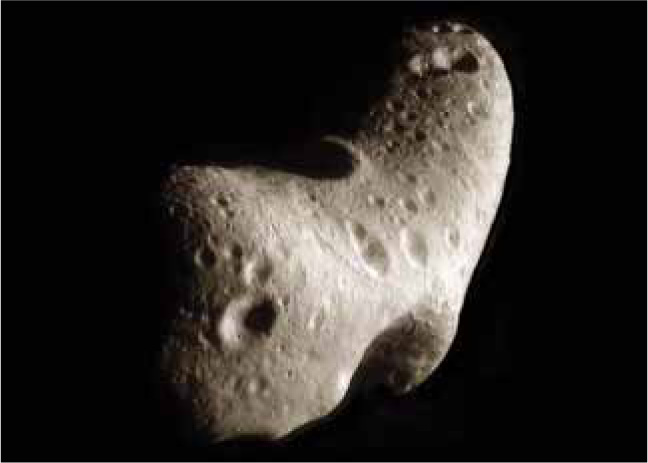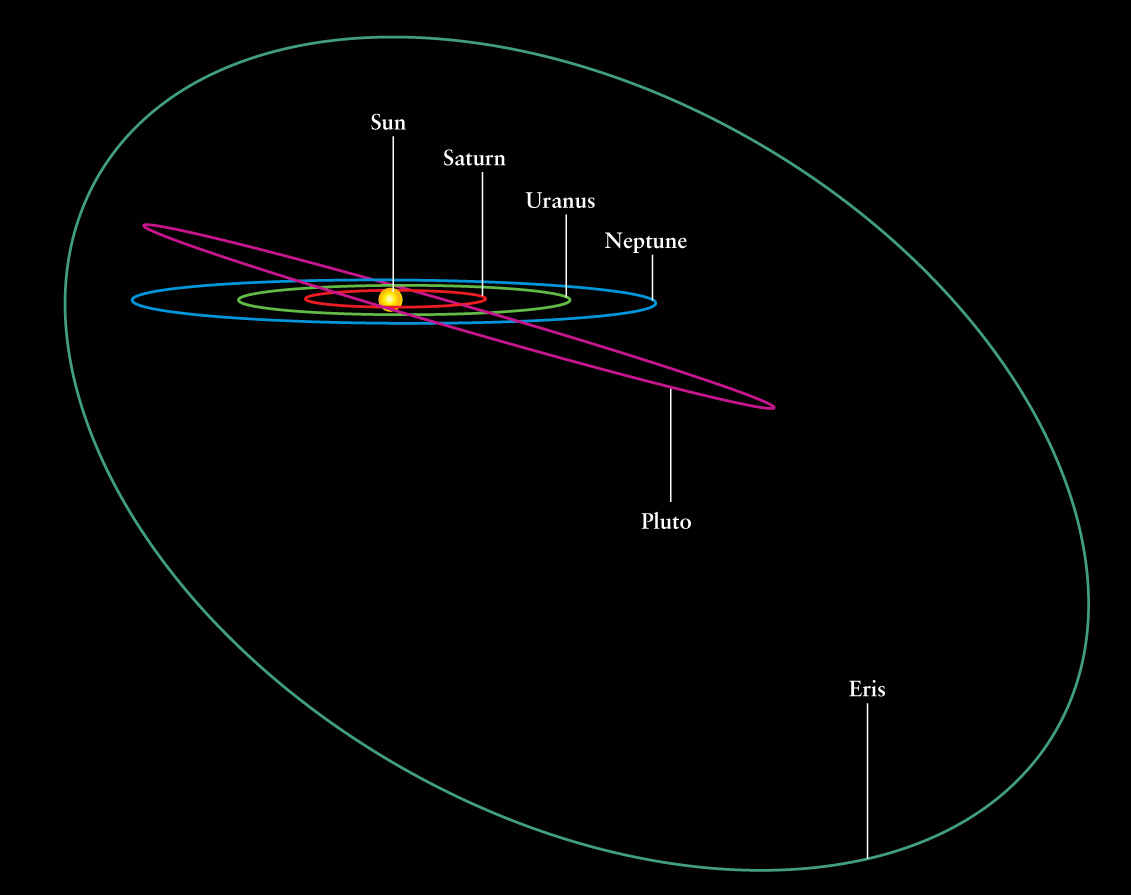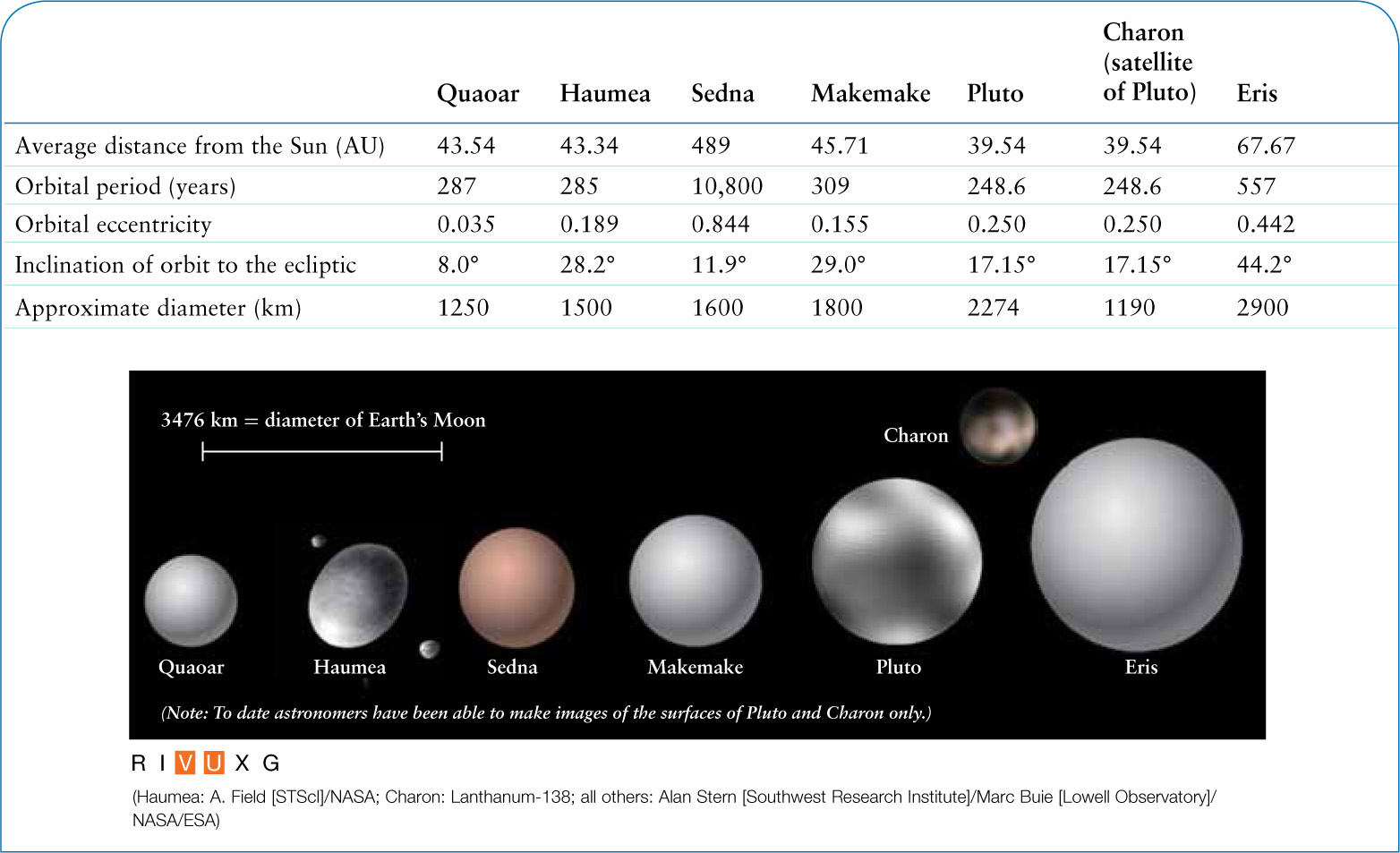7-5 Small chunks of rock and ice also orbit the Sun
The smaller bodies of the solar system contain important clues about its origin and evolution
In addition to the eight planets, many smaller objects orbit the Sun. These objects fall into three broad categories: asteroids, which are rocky objects found in the inner solar system; trans-Neptunian objects, which are found beyond Neptune in the outer solar system and contain both rock and ice; and comets, which are mixtures of rock and ice that originate in the outer solar system but can venture close to the Sun.
Asteroids
Within the orbit of Jupiter are hundreds of thousands of rocky objects called asteroids. There is no sharp dividing line between planets and asteroids, which is why asteroids are also called minor planets. The largest asteroid, Ceres, has a diameter of about 900 km (around one-quarter our Moon’s diameter). The next largest, Pallas and Vesta, are each about 500 km in diameter. Still smaller ones, like the asteroid shown in close-up in Figure 7-7, are more numerous. Hundreds of thousands of kilometer-sized asteroids are known, and there are probably hundreds of thousands more that are boulder-sized or smaller. All of these objects orbit the Sun in the same direction as the planets.

An Asteroid The asteroid shown in this image, 433 Eros, is only 33 km (21 mi) long and 13 km (8 mi) wide—about the same size as the island of Manhattan. Because Eros is so small, its gravity is too weak to have pulled it into a spherical shape. This image was taken in 2000 by NEAR Shoemaker, the first spacecraft to orbit around and land on an asteroid.
Most (although not all) asteroids orbit the Sun at distances of 2 to 3.5 AU. This region of the solar system between the orbits of Mars and Jupiter is called the asteroid belt.
CAUTION!
One common misconception about asteroids is that they are the remnants of an ancient planet that somehow broke apart or exploded, like the fictional planet Krypton in the comic book adventures of Superman. In fact, the combined mass of all the asteroids (including Ceres, Pallas, and Vesta) is much less than the mass of the Moon, and they were probably never part of any planet-sized body. The early solar system is thought to have been filled with asteroidlike objects, most of which were incorporated into the planets. The “leftover” objects that missed out on this process make up our present-day population of asteroids.
CONCEPT CHECK 7-8
Is the largest asteroid, Ceres, about the same size as a large city, a large U.S. state, a large country, or Earth itself?
Ceres has a diameter of about 900 km. This is about the same size as a large U.S. state, such as the length of California.
Trans-Neptunian Objects
While asteroids are the most important small bodies in the inner solar system, the outer solar system is the realm of the trans-Neptunian objects. As the name suggests, these are small bodies whose orbits lie beyond the orbit of Neptune. The first of these to be discovered (in 1930) was Pluto, with a diameter of only 2274 km. This is larger than any asteroid, but smaller than any planet or any of the moons listed in Table 7-2. The orbit of Pluto has a greater semimajor axis (39.54 AU), is more steeply inclined to the ecliptic (17.15°), and has a greater eccentricity (0.250) than that of any of the planets (Figure 7-8). In fact, Pluto’s noncircular orbit sometimes takes it nearer the Sun than Neptune. (Happily, the orbits of Neptune and Pluto are such that they will never collide.) Pluto’s density is only 2000 kg/m3, about the same as Neptune’s moon Triton, shown in Table 7-2. Hence, its composition is thought to be a mixture of about 70% rock and 30% ice.

Since 1992 astronomers have discovered more than 900 other trans-Neptunian objects, and are discovering more each year. Like asteroids, the vast majority of trans-Neptunian objects orbit the Sun in the same direction as the planets. A handful of trans-Neptunian objects are comparable in size to Pluto; at least one, Eris, is even larger than Pluto, as well as being in an orbit that is much larger, more steeply inclined, and more eccentric (Figure 7-8). Table 7-4 lists the seven largest trans-Neptunian objects known as of this writing. (Note that Charon is actually a satellite of Pluto.) Haumea and its two moons are shown. While Haumea’s shape has not been observed directly, modeling of its fuzzy image suggests that it is unusually elongated, possibly from a collision.
TABLE 7-4 Seven Large Trans-Neptunian Objects

Just as most asteroids lie in the asteroid belt, most trans-Neptunian objects orbit within a band called the Kuiper belt (pronounced “ki-per”) that extends from 30 AU to 50 AU from the Sun and is centered on the plane of the ecliptic. Like asteroids, many more trans-Neptunian objects remain to be discovered: Astronomers estimate that there are 35,000 or more such objects with diameters greater than 100 km. If so, the combined mass of all trans-Neptunian objects is comparable to the mass of Jupiter, and is several hundred times greater than the combined mass of all the asteroids found in the inner solar system.
Like asteroids, trans-Neptunian objects are thought to be debris left over from the formation of the solar system. In the inner regions of the solar system, rocky fragments have been able to endure continuous exposure to the Sun’s heat, but any ice originally present would have evaporated. Far from the Sun, ice has survived for billions of years. Thus, debris in the solar system naturally divides into two families—rocky asteroids and partially icy trans-Neptunian objects—which can be arranged according to distance from the Sun, just like the two categories of planets (terrestrial and Jovian).
CONCEPT CHECK 7-9
Is Pluto an asteroid, planet, Kuiper belt object, or trans-Neptunian object?
Pluto orbits beyond Neptune. All such objects are called trans-Neptunian objects. One group of trans-Neptunian objects—including Pluto—orbits in the Kuiper belt, so Pluto is both a trans-Neptunian object and a Kuiper belt object. Pluto is neither a planet nor an asteroid.
CALCULATION CHECK 7-3
Which has a larger average orbital radius, the asteroid belt or the Kuiper belt?
The asteroid belt is located between Mars and Jupiter at about 3 AU from the Sun, whereas the much larger Kuiper belt is beyond the orbit of Neptune and is located between about 30 and 50 AU from the Sun.
Comets
Two objects in the Kuiper belt can collide if their orbits cross each other. When this happens, a fragment a few kilometers across can be knocked off one of the colliding objects and be diverted into an elongated orbit that brings it close to the Sun. Such small objects, each a combination of rock and ice, are called comets. When a comet comes close enough to the Sun, the Sun’s radiation vaporizes some of the comet’s ices, producing long flowing tails of gas and dust particles (Figure 7-9). Astronomers deduce the composition of comets by studying the spectra of these tails.

A Comet This photograph shows Comet Hale-Bopp as it appeared in April 1997. The solid part of a comet like this is a chunk of dirty ice a few tens of kilometers in diameter. When a comet passes near the Sun, solar radiation vaporizes some of the icy material, forming a bluish tail of gas and a white tail of dust. Both tails can extend for tens of millions of kilometers.
CAUTION!
Science-fiction movies and television programs sometimes show comets tearing across the night sky like a rocket, which would be a pretty impressive sight. However, comets do not zoom across the sky. Like the planets, comets orbit the Sun. And like the planets, comets move hardly at all against the background of stars over the course of a single night (see Section 4-1). If you are lucky enough to see a bright comet, it will not zoom dramatically from horizon to horizon. Instead, it will seem to hang majestically among the stars, so you can admire it at your leisure.
Some comets appear to originate from locations far beyond the Kuiper belt. The source of these is thought to be a swarm of comets that forms a spherical “halo” around the solar system called the Oort comet cloud (also known as Oort cloud). This hypothesized “halo” extends to 50,000 AU from the Sun (about one-fifth of the way to the nearest other star). Because the Oort cloud is so distant, it has not yet been possible to detect objects in the Oort cloud directly.
CONCEPT CHECK 7-10
Consider a comet that has an orbital plane that is perpendicular to the plane of Earth’s orbit around the Sun. Did this comet most likely originate from the Kuiper belt or the Oort cloud?
Whereas the Kuiper belt lies in the same plane as Earth’s orbit around the Sun, the Oort cloud is a spherical distribution of comets that completely surrounds the solar system. If a comet has an orbit that is considerably different from that of the flat plane of the solar system, it most likely came from the spherical Oort cloud that exists in all directions around our solar system.